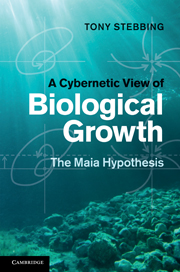Book contents
- Frontmatter
- Contents
- Foreword by Ernest Naylor
- Preface: ‘A fragment of a possible world’
- Acknowledgements
- 1 Introduction
- 2 Growth unlimited: blooms, swarms and plagues
- 3 Self-regulating systems: from machines to humans
- 4 The wealth of homeodynamic responses
- 5 A cybernetic approach to growth analysis
- 6 A control mechanism for Maia
- 7 The three levels of adaptation
- 8 Population growth and its control
- 9 Hierarchy: a controlled harmony
- 10 History of hormesis and links to homeopathy
- 11 Maian mechanisms for hormesis and catch-up growth
- 12 Cellular growth control and cancer
- 13 Human overpopulation
- 14 Our finite Earth
- 15 The Maia hypothesis and anagenesis
- Glossary
- Further reading
- References
- Index
4 - The wealth of homeodynamic responses
Published online by Cambridge University Press: 10 January 2011
- Frontmatter
- Contents
- Foreword by Ernest Naylor
- Preface: ‘A fragment of a possible world’
- Acknowledgements
- 1 Introduction
- 2 Growth unlimited: blooms, swarms and plagues
- 3 Self-regulating systems: from machines to humans
- 4 The wealth of homeodynamic responses
- 5 A cybernetic approach to growth analysis
- 6 A control mechanism for Maia
- 7 The three levels of adaptation
- 8 Population growth and its control
- 9 Hierarchy: a controlled harmony
- 10 History of hormesis and links to homeopathy
- 11 Maian mechanisms for hormesis and catch-up growth
- 12 Cellular growth control and cancer
- 13 Human overpopulation
- 14 Our finite Earth
- 15 The Maia hypothesis and anagenesis
- Glossary
- Further reading
- References
- Index
Summary
The broadest and most complete definition of Life will be – The continuous adjustment of internal relations to external relations.
Herbert SpencerThe maintenance of an invariant configuration in spite of variable disturbances defines the problem of homeostasis.
Francis HeylighenADAPTATION AND CHANGE
Adaptation to variable and harsh environments is a central theme of evolution. From the North and South poles through the temperate regions to the equator, there is variability to learn to live with. Much of that variability follows a pattern and, in a sense, it is predictable. Daily, lunar and annual seasonal patterns of variability dictate the behaviour of nearly all forms of life. What is important here is that those events on Earth that relate to the cycling of the sun and the moon have remained unchanged for so long that animals have evolved adaptive rhythmical patterns of behaviour that are encoded in their genomes. The behaviour is instinctive and simply part of what they do with regularity.
But what about adaptation to erratic events that follow no pattern, fluctuating from minute to minute, and from hour to hour? In a single place, one may expect continuous variation of temperature and humidity, but if one were moving around continually in flight like a bumble bee, or running around on the ground like a mouse, the changes sensed would be quite different from those at a single location. So variation experienced by the organism is not simply about change with time, but also change from place to place.
- Type
- Chapter
- Information
- A Cybernetic View of Biological GrowthThe Maia Hypothesis, pp. 69 - 92Publisher: Cambridge University PressPrint publication year: 2010



